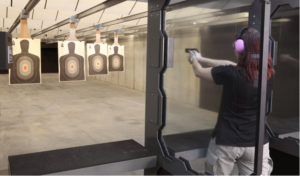The Newport Rifle Club, founded in 1876, is the oldest continuously operating rifle club in the United States. When our kids were younger, my friend and I would take them out to dinner once a month on a Friday and go to the club for kids’ night, where they’d shoot .22 rifles. First, they’d review gun safety basics, then grab a mat, and target shoot for about an hour. It was a great time.
Education and practice is a huge piece of the journey to becoming comfortable with a firearm. Our Friday night shoots were a great benefit for my kids. The club also offers a woman-only basic pistol course. Laura Damon of the Newport Daily News attended a recent course and writes:
MIDDLETOWN — A Newport woman had a Mason jar of green juice on the table next to her National Rifle Association book; she was a few minutes late to the gun course at the Newport Rifle Club because she had stopped by a farmers market on her way in. She practices yoga, and she wanted to learn how to safely shoot a firearm.
“If I ever had to know how to use a gun and I didn’t know, that would be unfortunate,” the woman, who wished to remain anonymous, said on Saturday during a seven-hour women-only NRA Basic Pistol Shooting Course.
The club, founded in 1876 and the oldest continuously operating rifle club in the United States, has approximately 700 members, and about 20 percent of them are women. The women-only basic pistol course has been offered at the club for about 10 years now, and there’s recently been an uptick in interest among women to enroll in the course, said David Balasco, chief instructor at the club.
“We’ve got a lot of teachers coming through, too,” Balasco said.
Six women total, including this reporter, took Saturday’s course.
The course isn’t a requirement for those interested in purchasing a firearm or obtaining a license, but it provides basic information to first-time shooters and people with little experience with firearms. The Newport woman who enrolled in the course is interested in taking the required test to receive a “blue card,” a document that is required to purchase a handgun in Rhode Island. She said Saturday’s course would give her a solid foundation before she takes the test.
She took the course once before, a few years ago, she said, but wanted a refresher. She originally took the course because she feared guns, she said. “I don’t like that feeling; it feels scary to not know,” she told the group of women and instructors.
“Knowledge is important,” said Mick Souza, a National Rifle Association certified instructor who taught portions of Saturday’s course.
Another Newport woman, who also wished to remain anonymous, enrolled in Saturday’s course because she’s interested in owning a gun for self-defense, she said. A Cumberland woman, who wished to remain anonymous, took the course because her brother encouraged her to.
With patience and humor, certified course instructors and members of the Newport Rifle Club took turns teaching the women the basics of pistol shooting. Safety was the principal lesson taught, and throughout the day the women were encouraged to repeat the three NRA gun safety rules: always keep the gun pointed in a safe direction, always keep the finger off the trigger until ready to shoot and always keep the gun unloaded until ready to use.
“That’s going to be embedded in your head,” Souza said. “And you’re going to feel safe.”
According to the NRA pistol shooting publication supplied to each woman in the course, a common definition for the word “pistol” is “a gun that has a short barrel and can be held, aimed and fired with one hand.” Pistol refers to all types of handguns, and many different types exist. They include revolvers, semiautomatics, muzzleloaders, hinge-actions, bolt-actions and air pistols. The instructors and the female students concentrated on the two most common types of pistols in use today: revolvers and semiautomatics.
Before the women practiced shooting in the club’s indoor range, they learned the anatomy of revolvers and semiautomatics. They were versed in the nomenclature of the firearms and encouraged to hold unloaded guns and identify the various parts. They learned the components of cartridges: the case, primer, powder charge and bullet, and the physics behind how the projectile is spat from the pistol’s muzzle.
Again stressing safety, the women learned that the cartridge has to match the firearm it’s going into, and they were taught the various types of cartridge malfunctions like misfires, hangfires and squib loads, and what to do should those situations arise.
Using a laser gun, the women practiced proper grip, stance and breath control. Again they were instructed to keep their fingers off the triggers until ready to shoot; Balasco joked that it is a rule so ingrained in his mind, he’ll pick up a Windex bottle and keep his finger far from the trigger until he’s ready to spray.
In the firing range, wearing safety glasses and ear protection, the women shot revolvers and pistols with various ammunition sizes; each woman was paired with an instructor.
This reporter improved at firing a Beretta 9-millimeter semiautomatic pistol after improving trigger control. Trigger control is one of the most important shooting fundamentals and refers to the technique of pulling the trigger without causing any movement of the aligned sights; it’s achieved by applying gradually increasing pressure to the trigger until the shot is fired. The goal of the technique is to produce a “surprise break” in which the shooter can’t predict the exact moment the gun will fire; it reduces the chances of the shooter anticipating the recoil of the shot and thus makes the shot more accurate.
The women also shot a Smith & Wesson 1911 with .45 caliber ammunition; the pistol had a wooden grip and ornate fish scales etched into its slide.
Melissa Denis of Manchester, New Hampshire, was a first-time shooter. She took the class with her friend, Michelle Marchetti of Warwick, who had previous experience shooting firearms. Marchetti’s husband is a member of the Newport Rifle Club. Marchetti took the course for “more education, to feel more comfortable,” she said.
Denis took the course for safety education purposes; besides, “I’ve always wanted to learn,” she said.
She said she wasn’t necessarily nervous or fearful in the moments leading up to firing a gun for the first time. “I just didn’t know what to expect,” Denis said. “Now it’s just fun … I can’t wait to do it again.”
Read more here.
E.J. Smith - Your Survival Guy
Latest posts by E.J. Smith - Your Survival Guy (see all)
- “What Do You Do If the Market Crashes?” - April 19, 2024
- Costco Gold Bars Sell Out Despite Premium Price - April 19, 2024
- A Wise Man’s Take on the Boston Bruins Playoff Chances - April 19, 2024
- Is Your Retirement Life a Mess? Let’s Talk - April 18, 2024
- Your Survival Guy Learns from Marie Kondo - April 18, 2024















